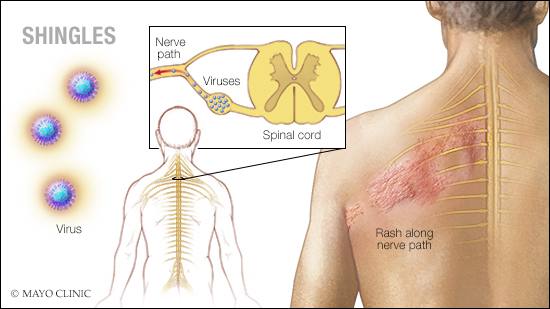-
Mayo Clinic Q and A: New shingles vaccine recommended for most adults over age 50
 DEAR MAYO CLINIC: How effective is the shingles vaccine? Who should get it? Is it recommended even for those who have already had shingles?
DEAR MAYO CLINIC: How effective is the shingles vaccine? Who should get it? Is it recommended even for those who have already had shingles?
ANSWER: A new vaccine, called Shingrix, is now available that’s very effective in preventing shingles. The Centers for Disease Control and Prevention (CDC) recommends that everyone age 50 and older with a healthy immune system receive this vaccine, whether you’ve had shingles before or not.
Unlike the other vaccine that’s been available for shingles since 2006, called Zostavax, this new vaccine is inactivated. That means it does not contain a live virus. Because of that, it is safe in people who have weakened immune systems. However, the CDC has not yet made recommendations for Shingrix vaccination in these individuals. If you have a weakened immune system, talk to your health care provider about your vaccination options for shingles.
Shingles is caused by a virus called varicella-zoster. When you’re first infected with this virus, it causes the itchy rash known as chickenpox. Although chickenpox is uncomfortable, most people recover from it without any lasting problems. But after the rash of chickenpox goes away, the virus does not. Instead, the varicella-zoster virus goes into hiding in your body’s nerve cells.
As you grow older, when your body is stressed — sometimes because of another infection or perhaps due to medications that suppress your immune system — the varicella-zoster virus can be reactivated. But rather than getting a whole-body rash again, you get a rash just in the areas supplied by the nerve where the virus is activated.
Shingles typically involves a band-like rash on the chest, back or face. The rash usually is quite painful. Most people recover from shingles in a few days, but a small number go on to develop severe pain along the nerve that was irritated when the virus came back. This lingering pain, called postherpetic neuralgia, may last for weeks to months after the shingles episode. In some cases, the pain can be severe and very difficult to treat.
Research has shown Shingrix, the newly approved shingles vaccine, to be more than 90 percent effective in preventing shingles and the postherpetic neuralgia that can sometimes accompany it. You need to receive two doses of Shingrix, with the doses two to six months apart. The vaccine is given as a shot in the upper arm. After you receive two doses, the vaccine offers long-term protection against the virus reactivating. Shingrix is approved and recommended for people older than 50, including those who have had shingles before and those who previously received Zostavax.
That said, there are a few groups of people who should not receive Shingrix. Don’t get the vaccine if you’ve had an allergic reaction to a previous dose of the vaccine. Shingrix is not recommended for women who are pregnant or breastfeeding. If you have shingles, wait until the rash goes away before receiving the vaccine. If you recently received the live shingles vaccine, Zostavax, wait at least eight weeks before receiving Shingrix.
The most common side effects of the shingles vaccine are redness, pain, tenderness and swelling at the injection site; muscle pain; tiredness; headache; shivering; fever; and upset stomach. Although a small percentage of people may still get shingles despite receiving a vaccination, the vaccine may reduce the severity and duration of shingles, and it decreases the risk of developing postherpetic neuralgia.
If you’re 50 or older, talk to your health care provider about getting the shingles vaccine. It provides strong protection against shingles and postherpetic neuralgia, and plays an important role in preventive health care for older adults. — Dr. Priya Sampathkumar, Infectious Diseases, Mayo Clinic, Rochester, Minnesota







